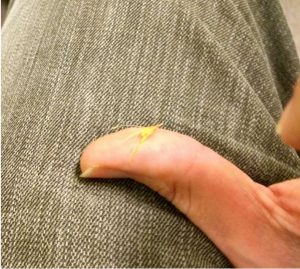You know Labs: They love being outside, following their noses as they weave out of fields and grasses. But that eagerness could cause trouble if they rub a foxtail the wrong way.
What is a foxtail?
Foxtails grow as bunches of grass with little spiky seeds. According to the US Forest Service, foxtail grows almost everywhere across the country and in Canada.
The barbs on the weeds are what dog owners should be aware of; they can literally impale your dog. “The foxtail awn has a sharp, pointy end that allows it to easily penetrate the skin and other tissues, and microscopic barbs prevent it from backing its way out,” veterinarian Jennifer Coates said.

Noah & Sarah. Credit: Sarah Lou McIntyre
Foxtail troubles
Lab owner Sarah Lou McIntyre’s foxtail trouble started after she and her dog Noah went for a romp outside their Northern California home. A foxtail became lodged near his head.
“It was awful and ended up creating a pocket between his jaw and the bottom of his neck,” McIntyre said. “He had difficulty breathing. He had to have surgery. It was very scary.”
And Lab owner Alex Tran’s foxtail trouble started after she and her dog, Pennsters, went for a hike around Seattle.
“We went home, and I noticed she was scratching her eye furiously,” Tran said. “I thought maybe something got into her eye. I peeled her eyelids back and saw nothing. I washed it out with saline water and waited to see if things got better. They didn’t.”
After Pennsters’ eye became swollen and red Tran raced her to the vet and got quite a surprise.
“They pulled out a foxtail from her eye,” Tran said. “The procedure took seconds. They put a dye in her eye to find the foxtail. They placed it in my hand. My dog took antibiotics after that for a week. Within days, she was acting perfectly normal again.”
Veterinarian Ruth MacPete says she’s seen a lot unfortunate dog versus foxtail encounters. “Sadly, I have removed foxtails from just about everywhere on dogs: nostrils, ears, mouth, in between toes, and more,” MacPete said.
Why are foxtails so dangerous?

Credit: Alex Trans
Those barbs on foxtails are the culprit and can even be deadly to your dog if left unattended.
“Foxtail has a tendency to burrow deeper into tissues as time goes on,” Coates explained. “They may even penetrate through the chest or abdominal wall and into internal organs.”
If the barbs are not taken out quickly, they can cause an infection or a devastating injury. “Foxtail often sticks to a dog’s cornea or get trapped under their eyelids,” MacPete said. “These ocular foreign bodies not only cause pain but can lead to corneal ulcerations if not removed promptly.”
Some vets warn how summer is high season for foxtail. “They can be very challenging to remove,” veterinarian Gary Richter said. “Depending on where the foxtail is found, a dog may need to be sedated and brought into surgery. On rare occasions, an infected foxtail can become life-threatening.”
How can you spot a foxtail problem?
If your dog has been out playing in tall grass or fields, or if you’ve spotted foxtails, watch your dog closely for symptoms.
“Symptoms will vary based on the location of the foxtail,” Coates said. “For example, chronic drainage from a firm mass is typical with a foxtail located under the skin while sudden sneezing attacks can occur with foxtails in the nasal passages.”
You should also examine your Lab after he comes in from a walk or hike so that you can identify any foxtails or lacerations sooner rather than later.
What should you do?
If you suspect your dog inhaled, ingested, or has a health issue related to a foxtail, get to your vet right away.
“The only way to treat problems associated with foxtails is to completely remove all of the plant material. Extensive surgery may be necessary if the awn is deep within tissues,” Coates said. “Antibiotics are often necessary to deal with secondary infections.”
MacPete’s advice: If you see foxtails, avoid them.
“I recommend pet parents try to keep their pets away from foxtails when out on hikes and walks, and that they check their dog’s fur and in between their toes for foxtails and burrs after coming inside,” MacPete said. “And of course, if you suspect your dog may have a foxtail stuck in between their toes or elsewhere, be sure to take your pet to your veterinarian right away.”
Mary Schwager, aka WatchdogMary is a TV and print journalist now watchdogging for animals. Honored to have won 14 Emmy, 7 Edward R. Murrow and Associated Press awards for investigative reporting and writing. She loves tips, so send your story ideas to www.watchdogmary.com.







